Feasibility Study
Finding a reliable mechanic or garage in the UK is challenging. However, owning a car in the UK is a dream of every young family. Challenges arise when a car needs repair. Locating a garage can be a problem especially for ladies. According to Ramaseshan, Ishak, and Kingshott (2013), many businesses have been focusing on modern technology to enable customers to locate garages, gas stations, and petrol stations. For instance, the ICICI Lombard insurance policy allows customers to locate nearby garages through their Insure app. This app allows customers to locate nearby petrol station, garage, and insurance broker. However, the main focus of this app is the insurance policy for their customers. Liu, Au, and Choi (2014) noted that although the app allows customers to locate garages, it does not incorporate important elements such as price comparison and exact location. Another app that allows customers to locate garages is Trust My Garage. It is the most competitive app that enables customers to locate the exact position of their nearby garage (Trust My Garage 2017). Although the garage has a significant market share, customer awareness is low.
The garage has less than 1 million members. This number is significantly low compared with car owners in the UK (Hill, Jones & Schilling 2014). According to Dunnett (2013), there are over 30million car owners in the UK, an indicator that the market potential is huge. It is against this backdrop that this report seeks to develop a marketing plan for an app that will enable customers to locate garages in the UK. The app will be developed by the Independent Garage Association, a retailer motor industry federation that has experience in developing apps for independent garages in the UK (Bunce, Harris & Burgess 2014; Huang & Sarigöllü 2014; Pilcher 2016). One of the key factors that the garage will integrate into the app is an appealing customer profile. Customers will have individual profiles where they can upload up to five cars. On the other hand, businesses will upload a maximum of ten photos. It is projected that the membership will reach 2 million customers in the next three years. This objective will be achieved through proper marketing and improved efficiency (Trust Garage 2017).
Grünewälder (2015) noted that marketing enables firms to build their brand image. Spot Garage intended to leverage modern technology to market its brand name. Since many people use social media including Facebook, Twitter, and Instagram, the firm will market the app on social media especially in the first 5 months after launching the app. This app will also allow members to locate nearby gas and petrol station, an element that will allow them to contact the garage immediately (Powell, Landman & Bates 2014).
Grünig and Morschett (2017) elucidated that product development strategies of Spot Garage can be analyzed using the Ansoff matrix. Product marketing strategies of Spot Garage were considered after a critical analysis of the market using the Ansoff matrix. The purpose of this matrix is to enable new products to grow and penetrate the market. The Ansoff matrix will help to guide managers in development, diversification, and penetration to the new market.
The product development of Spot Garage falls under the diversification quadrant. Spot Garage is a new app, which will help customers to locate garages in the UK. The app will then expand to other market segments. Spot Garage will employ a diversification strategy because the app is completely new and is being introduced in a new market. This means that the strategies employed must ensure the new app penetrates the market because it falls under the risk zone in the quadrant as shown in the Ansoff Matrix below.
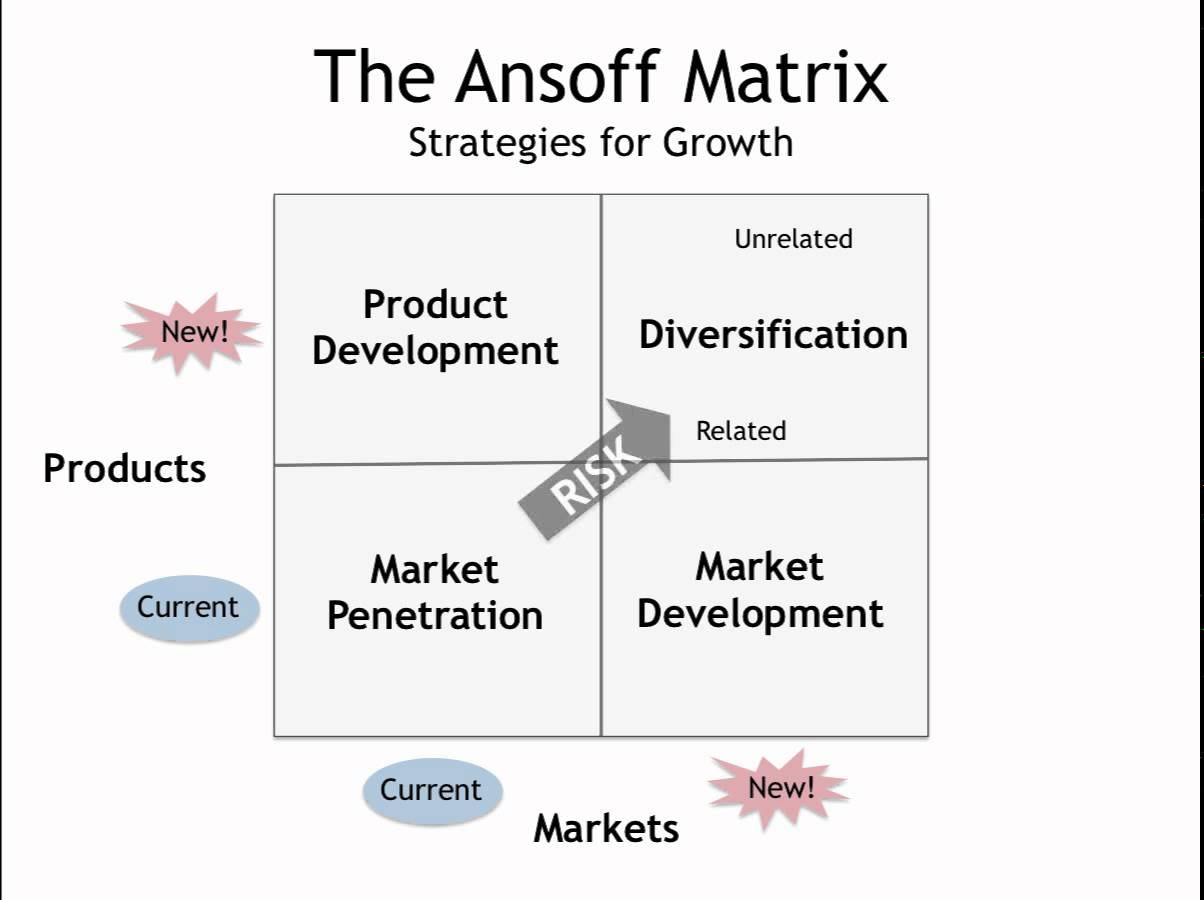
According to Zeriti et al. (2014) market diversification strategy applies when a firm intends to introduce a new product in the new market. Spot Garage intends to introduce its new app in the market but shall later consider expanding into insurance and security services. This strategy has proven successful with different companies such as Samsung. Samsung began as a trading company but later expanded into insurance and security markets. However, today, Samsung is known for its ability to produce high tech electronics (Zheng et al. 2014).
Business Plan
Executive Summary
Kirwan (2017) noted that Spot Garage is a startup business that offers UK customers with access to nearby garages everywhere in the UK. The business product is an app that allows customers to receive full-featured GPS and guided maps to all garages within a five-kilometer of the member. The app also allows customers to search for garages in certain cities and states in the UK. Spot garage will help members to locate not only the nearby garage but also a free Google map and nearby petrol station. It is expected that the app will grow its membership from zero to 300,000 by the end of the year (appendix 2). Although there are other players in this industry, they tended to offer a single product. As a start-up, offering multiple services will all the business to raise more capital as it expands into a new market. This app is a multipurpose product because it allows customers not only to locate garages but also to tell them when the vehicles need servicing.
Company Description
Spot Garage is a limited liability company registered in the UK. The firm seeks to introduce GPS technology on an app to help customers locate nearby garage all over the UK. Although it is a limited liability company, the firm has partnered with the Independent Garage Association which has limitless access to thousands of garages all over the UK. Spot Garage will allow the independent garage association to own 15-percent of total share capital. This means that the association will have direct control over management decisions. This aspect is essential considering that owners have little knowledge of motor vehicle repair and charges. The independent garage association will help in determining the charges and location of thousands of garages all over the UK.
Concept of the App
Spot garage is in the auto repair market which has few but competitive market players. However, these players offer a single product or many but unrelated services. Spot garage will differentiate its services by not only allowing customers to locate garages but also to identify their current location and nearby petro station. This app is completely different from other apps where a customer has to key in their current location to locate nearby garages. The app has an automatic update on the current location based on the GPS location.
The app will be available online where members can access free downloads to create individual profiles. This data will help the company to identify its marketing strategies. One disadvantage of startup businesses in this industry is the lack of appropriate customer profile information (Leonidou, Katsikeas & Morgan 2013). Once the company has more than 100,000 customers, this data will be used to segment-specific services based on geographical locations and demographics (Chhabra 2015). Murynets (2012) holds that customers should check their data packages with service providers to enjoy these services.
Marketing Strategies
Spot garage intends to apply a well-thought-out marketing plan to ensure the app attracts new members. The first marketing strategy is to ensure the app is useful. According to Ishtiaq Ishaq and Munazer Hussain (2016), it does not matter how much money a firm has spent on creating new products, it will fail terribly if it does not offer something that interests customers. According to Palmer, Simmons, and Mason (2014), big companies understand the importance of developing something useful to customers. They ensure their apps are useful to their target customer base.
Moreno-Munoz et al. (2016) noted that apps can leverage modern technology to create something the general public is going to consider using. For instance, the Squat app is a useful app for travelers who intend to use the nearest public restroom.
The best marketing strategy for spot garage app is using QR codes (Atkinson 2013). Spot garage will add this code to its website, brochure, and receipt. On the Google play store, the app shall have one page dedicated to its mobile coupon app (Kim & Yoon 2014). This page will allow members to understand the services they will get access to after they have downloaded the app (Xu et al. 2015). This page will also contain a QR on the regular coupon mailers.
Spot garage will also market its app on social media. In this category, social media shall also involve posting a guest blog that related to motor repairs and the best garages in town. Specifically, the spot garage will advertise this app on Facebook, Twitter, and Instagram (Tiago & Veríssimo 2014; Brusse et al. 2014; Radtke 2014).
Goldsmith and Tsiotsou (2012) noted that the business will connect social media with a blog that will be used to advertise the app. Today, guest blogging has become an effective marketing tool. It is considered the best way of building an audience. Members of the independent garage association will be responsible for posting guest blogs every once per week.
Competitive Analysis
Competitive analysis is an effective tool that enables businesses to evaluate the core strength before entering the market. Competitive analysis will enable Spot Garage to gauge its performance and competitive advantage compared to other apps in the same market. This can be achieved by using SWOT analysis and Porter’s Five Force Model.
SWOT Analysis
Porters Five Force Model
The Porters Five Force Model helps businesses to analyze the level of competition in the industry (Dobbs, 2014).
Bargaining Power of Suppliers
The bargaining power of suppliers is low. Since the app is developed through a partnership with the Independent Garage Association, there are no suppliers required to deliver any product for the app to continue functioning
Bargaining Power of Customers
The bargaining power of customers is moderate. Customers using the app can decide to either find a garage themselves or use the app. Since the app is new in the market, Spot Garage has to consider the cost charged to its customers.
Competitive Rivalry
Competition rivalry in this industry is high. Although there are few players in the market, Trust My Garage offers customers competitive prices. Moreover, customers prefer a well-establish firm instead of a new product that has not to be tested.
The threat of Substitute Product
The threat of substitute products in this market is high. Technology keeps changing every day. There are substitute apps that offer garage location as an added advantage such as those of insurance companies. As a result, customers might prefer to locate garages using insurance Apps.
The threat of New Entrant
The threat of new entrants is high because there are no market barriers. Anyone can develop their app and entry this market. Moreover, there are fewer government regulations in this industry. Liao, Rice, and Lu (2015) reveal that one of the major competitive elements in the spot garage app is its ability to identify nearby garages, petrol, and gas stations and. Trust My Garage, the chief competitor offers unrelated services such as parking. Spot garage is unique in the sense that it allows customers to identify their current location using GPS and Google maps before they can identify nearby garage (Boulos & Yang 2013; Ashley & Tuten 2015). Each nearby garage appears together with the name and number of its manager. This data will be provided by the Independent Garage Association (Eden & Ackermann 2013).
Design and development
The purpose of the app is to locate a nearby garage, petro station, and gas station. The app using GPS on Google Maps to identify the exact location of a nearby garage. The app is designed in such a way that members will be able to key in their details including those of their car (Teo et al. 2014).
Operational and Management
Spot garage will have the manpower of 20 employees in the first 8 months. However, after if the growth rate allows, the number of workers shall be evaluated upwards. The operations of the business will be located in different cities including England, Wales, Manchester, and Glasgow. The firm will adopt a hierarchical organizational structure to ensure quick decision making.
Financial Sector
The financial sectors show the costs required to start the business including prices and management costs. The income statement shows revenues and expenses in the first year of operation. The business will purchase equipment worth $5000 to improve service delivery (Appendix 1).
Break-Even Analysis
Break-even analysis shows that spot garage will breakeven after 73,650 sales. After this point, the business will enjoy revenue (appendix 2).
Profitability Ratios
Profitability ratios measure the ability of a firm to generate income with each dollar on investment in sales. The profitability ratios measure the percentage of sales left after deducting all operating expenses.
Net profit margin = net income/net sales = 60,040/156700 = 0.38
Spot garage only converts 38-percent of its sales into revenues. This is a good start because it means the firm will enjoy high revenues in the next five years if management can improve efficiency and keep up with modern technology.
Reference List
Ashley, C & Tuten, T 2015, ‘Creative strategies in social media marketing: An exploratory study of branded social content and consumer engagement’, Psychology & Marketing, vol. 32, no. 1, pp.15-27.
Atkinson, L 2013, ‘Smart shoppers? Using QR codes and ‘green’ smartphone apps to mobilize sustainable consumption in the retail environment’, International Journal of Consumer Studies, vol. 37, no. 4, pp.387-393.
Boulos, M & Yang, S 2013, ‘Exergames for health and fitness: the roles of GPS and geosocial apps’, International Journal of Health Geographics, vol. 12, no. 1, pp.18.
Brusse, C, Gardner, K, McAullay, D & Dowden, M 2014, ‘Social media and mobile apps for health promotion in Australian Indigenous populations: Scoping review’, Journal of Medical Internet Research, vol. 16, no. 12, pp.280.
Bunce, L, Harris, M & Burgess, M 2014, ‘Charge up then charge out? Drivers’ perceptions and experiences of electric vehicles in the UK’, Transportation Research Part A: Policy and Practice, vol. 59, no. 1, pp. 278-287.
Chhabra, D 2015, Strategic Marketing in Hospitality and Tourism: Building a ‘smart’ Online Agenda, Nova Science Publishers, New York, NY.
Dobbs, M., 2014. Guidelines for applying Porter’s five forces framework: a set of industry analysis templates. Competitiveness Review, 24(1), pp.32-45.
Dunnett, P 2013, The decline of the British motor industry: The effects of government policy, Routledge, New York, NY.
Eden, C & Ackermann, F 2013, Making strategy: The journey of strategic management, Sage, London.
Goldsmith, R & Tsiotsou, R 2012, Strategic marketing in tourism services, Emerald Group Publishing Limited, Bingley.
Grünewälder, A 2015, Analysis of Nokia‘s corporate, business, and marketing strategies: examination of Nokia’s strategy execution in three steps, Anchor, Hamburg.
Grünig, R & Morschett, D 2017, General strategic planning as the starting point for going international for new markets, Springer, Berlin, Heidelberg.
Hill, C, Jones, G & Schilling, M 2014, Strategic management: theory: an integrated approach. Cengage Learning, Boston.
Huang, R & Sarigöllü, E 2014, How brand awareness relates to market outcome, brand equity, and the marketing mix, Springer, New York, NY.
Ishtiaq Ishaq, M & Munazer Hussain, N 2016, ‘Creative marketing strategy and effective execution on performance in Pakistan’’, Revista de Administração de Empresas, vol. 56, no. 6, pp. 668-679.
Kim, E & Yoon, N 2014, Perceived QR code technological attributes in the smart shopping context, Journal of Global Fashion Marketing, vol. 5, no. 4, pp.297-307.
Kirwan, J 2017, IGA launches ‘trust my garage’ app for independent garages, Web.
Leonidou, C, Katsikeas, C & Morgan, N 2013, ‘Greening” the marketing mix: Do firms do it and do it pay off?’ Journal of the Academy of Marketing Science, vol. 41, no. 2, pp.151-170.
Liao, T, Rice, J & Lu, J 2015. ‘The vicissitudes of competitive advantage: Empirical evidence from Australian manufacturing SMEs’, Journal of Small Business Management, vol. 53 no. 2, pp.469-481.
Liu, C, Au, Y & Choi, H 2014, ‘Effects of Freemium Strategy in the Mobile App Market: An Empirical Study of Google Play’, Journal of Management Information Systems, vol. 31, no. 3, pp. 326-354.
Moreno-Munoz, A, Bellido-Outeirino, F, Siano, P & Gomez-Nieto, M 2016, ‘Mobile social media for smart grids customer engagement: Emerging trends and challenges’, Renewable and Sustainable Energy Reviews, vol. 53, no. 1, pp.1611-1616.
Murynets, I 2012, Optimal investment and marketing strategies, World Scientific, Singapore.
Palmer, M, Simmons, G & Mason, K 2014, ‘Web-based social movements contesting marketing strategy: The mobilization of multiple actors and rhetorical strategies’, Journal of Marketing Management, vol. 30, no. 4, pp. 383-408.
Pilcher, J 2016, ‘Mobile apps for educational purposes’, Journal for Nurses in Professional Development, vol. 32, no. 5, pp.15-17.
Powell, A, Landman, A & Bates, D 2014, ‘In search of a few good apps’, Jama, vol. 311, no. 18, pp.1851-1852.
Radtke, J 2014, ‘A closer look inside collaborative action: Civic engagement and participation in community energy initiatives’, People, Place, and Policy Online, vol. 8, no. 3, pp.235-248.
Ramaseshan, B, Ishak, A & Kingshott, R 2013, ‘Interactive effects of marketing strategy formulation and implementation upon firm performance’, Journal of Marketing Management, vol. 29, no. 11, pp. 1224-1250.
Teo, T, Wu, H, Shih, T & Tsai, F 2014, ‘The analysis of smartphone apps in geomatics education’, The International Archives of Photogrammetry, Remote Sensing and Spatial Information Sciences, vol. 40, no. 6, pp.93.
Tiago, M & Veríssimo, J 2014, ‘Digital marketing and social media: Why bother?’ Business Horisons, vol. 57, no. 6, pp.703-708.
Trust Garage 2017, Trust my garage on the app store, Web.
Trust My Garage 2017, Making trust my garage a household name at a glance, Web.
Xu, J, Kang, Q, Song, Z & Clarke, C 2015, ‘Applications of mobile social media: WeChat among academic libraries in China’, The Journal of Academic Librarianship, vol. 41, no. 1, pp.21-30.
Zerit, A, Robson, M, Spyropoulou, S & Leonidou, C 2014, ‘Sustainable export marketing strategy fit and performance’, Journal of International Marketing, vol. 22, no. 4, pp. 44-66.
Zheng, Y, Capra, L, Wolfson, O & Yang, H 2014, ‘Urban computing: Concepts, methodologies, and applications. ACM Transactions on Intelligent Systems and Technology (TIST)’, vol. 5, no. 3, pp.38.
Appendices
Appendix 1: Financial Forecasts
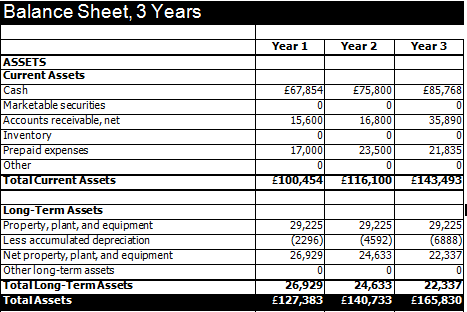
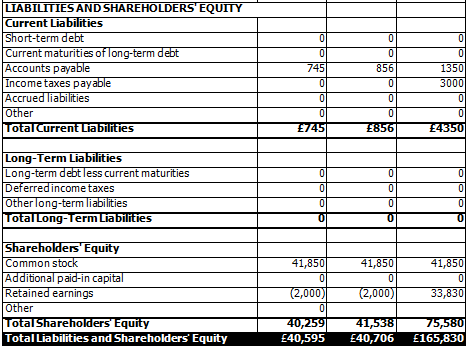
Appendix 2: Break-Even Analysis
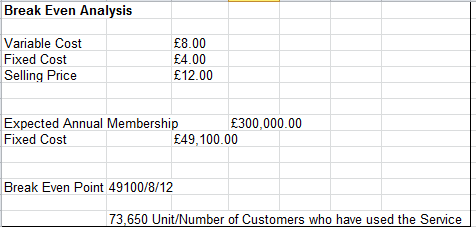
Appendix 3: Cash Flow Statement
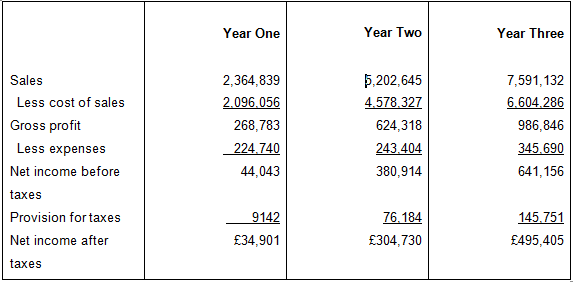
Appendix 4: Personnel Plan
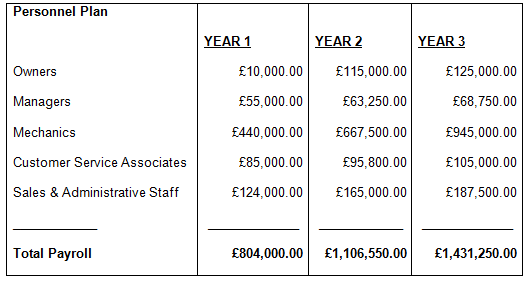
Appendix 5: Survey Questionnaire
How many cars do you own?
- One
- Two
- More than two
- None
What is (are) the brand(s) of your car(s)? [Tick against the brand(s) of your car(s)]
- BMW
- Flat
- Renault
- Toyota
- Nissan
- Mercedes Benz
- Audi
- Volkswagen
- Fiat
- Opel
- Peugeot
- Other (specify): _________________________________
How frequently does your car get repaired?
- Quarterly
- Once in 6 months
- Once a year
- At least 3 times a year
How many repair shops do you ask for assistance when your car needs fixing?
- One
- Two
- Three
- More than three repair shops
What criterion do you follow to choose your favorite repair shop(s)? (Multiple answers possible)
Time is taken to fix the car
- Nearness to residence area
- Courtesy car
- Repair charges
- Quality
- Customer care
- ther reasons
- _____________________________________________
- ____________________________________________
Where do you usually change your car oil?
- At the service station
- Car dealer
- At home
Do you seek opinions from experts/someone else before visiting the garage?
- Yes
- No
How do you rate the prices of the services offered by your garage?
- Expensive
- Reasonable
- Low-priced
- I do not know
- Would like to know
What type of service do you prefer for the repairs and/or maintenance of your car?
- An all-inclusive, expensive service
- Minimum, cheap service
Do you find information about your car(s) on the internet?
- Yes
- No
Have you ever used a garage app to locate a nearby repair shop?
- Yes
- No
- If yes, how do you rate the app?
- Good
- Excellent
- Inappropriate
- If no, would you like to use garage apps to locate and seek services from nearby repair shops?
- Yes
- No